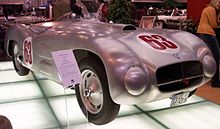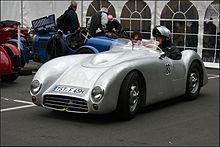AFM (racing car)

|
|
| Surname | Alexander von Falkenhausen engine construction |
|---|---|
| Companies | |
| Company headquarters | |
| Team boss | Alexander von Falkenhausen |
| statistics | |
| First Grand Prix | Switzerland 1952 |
| Last Grand Prix | Italy 1953 |
| Race driven | 4th |
| Constructors' championship | 0 |
| Drivers World Championship | 0 |
| Race wins | 0 |
| Pole positions | 0 |
| Fastest laps | 0 |
| Points | 0 |
AFM (the abbreviation should for A lexander of F alkenhausen M otorenbau are, according to other sources, the M would, however, M unich mean), founded by the Munich racer and designer Alexander von Falkenhausen , was a German racing team of the late 1940s and early 1950s Years that used racing cars of the same name. About a dozen chassis-only or complete racing vehicles were produced under the company name AFM.
Formula 2 car from AFM
With the advent of the Formula 2 class towards the end of the 1940s, various racing car designers who had little financial means tried to gain a foothold in motorsport using this racing formula. One of them was Alexander Freiherr von Falkenhausen. His company AFM first converted a BMW 328 into a single-seater. The vehicles got a conventional tubular frame, double wishbones and a De-Dion rear axle . Only parts of the substructure and above all the engine remained of the BMW 328, although this BMW six-cylinder engine was also revised.
The first of these cars appeared on German racing tracks as early as 1949, but were usually still inferior to the Veritas racing cars in Formula 2. The pre-war veteran Hans Stuck made a remarkable appearance with such a vehicle at the Italian Grand Prix in Monza in 1950 , where he spectacularly defeated none other than the Ferrari F1 driver and later double world champion Alberto Ascari in one of the races . In another run, Stuck was able to keep up with the front of the field for a long time before retiring again with engine problems.
Other racing drivers who took part in competitions at home and abroad with AFM vehicles: Teddy Vorster , Manfred von Brauchitsch , Fritz Riess , Hermann Lang , Helmut Niedermayr , Karl-Günther Bechem , Theo Fitzau , Willi Heeks , Karl Gommann, Peter Hirt and Willi Krakow .
The kitchen AFM
From 1949 the engineer Richard Küchen designed a promising, modern light metal V8 engine with double camshaft (only three or four units are said to have been built), with which Hans Stuck developed his own new and without an engine for the AFM-50 ordered by Falkenhausen. 4 (the 50 stood for the year of construction 1950, the 4 was the chassis serial number). This so-called AFM “kitchen” was driven by Stuck to various successes between 1950 and 1953. For example, Stuck won the Grenzlandring race with him in 1951 and in the same year was second in the Formula 2 category and fourth in the overall result at the legendary Schauinsland hill climb. At the beginning of 1953, the "Bergkönig" considered the kitchen V8, of which he is said to have owned two, as no longer sufficiently competitive, whereupon Stuck equipped his AFM-50-4 with a Bristol engine for further races .
Grand Prix statistics
| season | chassis | engine | tires | driver | 1 | 2 | 3 | 4th | 5 | 6th | 7th | 8th | 9 |
|---|---|---|---|---|---|---|---|---|---|---|---|---|---|
| 1952 | AFM |
|
|
|
|
|
|
|
|
||||
| Kitchens - V8 |
|
DNF | |||||||||||
| BMW Series - 6-cylinder |
|
DNF | |||||||||||
| BMW inline 6-cylinder |
|
9 | |||||||||||
| BMW inline 6-cylinder |
|
DNS | |||||||||||
| BMW inline 6-cylinder |
|
DNS | |||||||||||
| 1953 | AFM |
|
|
|
|
|
|
|
|
|
|||
| Bristol inline 6 cylinder |
|
DNF | 14th | ||||||||||
| BMW inline 6-cylinder |
|
DNF | |||||||||||
| BMW inline 6-cylinder |
|
DNF |
Passenger car project
In 1951 AFM presented the prototype of a luxurious coupé with the 2.5 liter . Similar to the AFM racing car, the vehicle had a low-lying tubular frame chassis with a wheelbase of 2850 mm. The front suspension consisted of double wishbones and coil springs. The rear axle had a three-point suspension with coil springs. The engine and transmission came from the Opel Kapitän (6 cylinders, 2473 cm³, 60 hp and 44 kW, respectively). The petrol tank held 90 liters. The body was made of light metal over a steel frame. The coupe had a modern pontoon body with recessed rear fenders. The equipment included a tour counter. A picture of the AFM 2.5 liter appeared in the Swiss Automobile Review in 1951 . The car was supposed to cost 16,000 DM, but did not go into series production. In addition to this coupé, a single convertible, called the AFM Super 2500 , was built by the Drews bodywork company .
literature
- David Hodges: Racing Cars from A to Z after 1945 , Motorbuch Verlag, Stuttgart 1994, p. 7, ISBN 3-613-01477-7 .
- Gloor, Roger: `` Post-War Car '', 2nd edition (1981), Hallwag AG, Bern, publisher of Automobil Revue , p. 48, ISBN 3-444-10263-1 .
Web links
- Phoenix from the flames, part 2: AFM (English)
- Alex von Falkenhausen's brave F2 effort (English)


